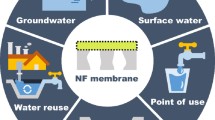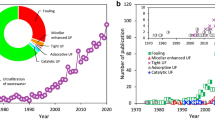Abstract
Cross-linked polydimethylsiloxane (PDMS)–polyetherimide (PEI) composite membranes were prepared, in which asymmetric microporous PEI membrane prepared with phase inversion method was acted as the microporous supporting layer in the flat-plate composite membrane. Membrane characterization was conducted by Fourier transform infrared and scanning electronic microscopy analysis. The composite membranes were employed in pervaporation separation of n-heptane–thiophene mixtures. Effect of amount of PDMS, cross-linking temperature, amount of cross-linking agent, and cross-linking time on the separation efficiency of n-heptane–thiophene mixtures was investigated experimentally. Experiment results demonstrated that 80–100°°C of cross-linking temperature was more preferable for practical application, as the amount of cross-linking agent was up to 20 wt.%, and 25 wt.% of PDMS amount was more optimal as far as flux and sulfur enrichment factor were concerned. In addition, the swelling degree of and stableness of composite membrane during long-time operation were studied, which should be significant for practical application.











Similar content being viewed by others
References
Hasan, M. (2003). Effect of ethanol–unleaded gasoline blends on engine performance and exhaust emission. Energy Conversion and Management, 44(9), 1547–1561.
Hamdan, M., & Subaih, T. (2002). Improvement of locally produced gasoline and studying its effects on both the performance of the engine and the environment. Energy Conversion and Management, 43(14), 1811–1820.
Bhattachayya, S., & Randip, K. (2001). Catalytic reduction of NO x in gasoline engine exhaust over copper- and nickel exchanged X-zeolite catalysts. Energy Conversion and Management, 42(15), 2019–2027.
Churchill, S. (1997). The reduction of air pollution by improved combustion. Energy Conversion and Management, 38(10), 1335–1341.
Kaygusuz, K. (2003). Energy policy and climate change in Turkey. Energy Conversion and Management, 44(10), 1671–1688.
Demirba, A. (2003). Bio-diesel fuels from vegetable oils via catalytic and non-catalytic supercritical alcohol transesterifications and other methods: a survey. Energy Conversion and Management, 44(13), 2093–2109.
Chen, H. (2004). Advances in desulfurization of FCC gasoline. Science & Technology in Chemical Industry, 12, 46–51.
Covert, C., Sherpherd, T. C., & Thompson, M. W. (2001). How Phillips s-zorb sulfur removal technology quickly came to life. World Refining, 11, 56–66.
Zhou, L., Mowry, J., & Hamm, D. (2002). FCC naphtha desulphurization by solvent extraction. Prepared for Presentation at AIChE 2002 Spring National Meeting, 3, 10–14.
Han, B., Li, J., Chen, C., & Wickramasinghe, R. (2002). Computer simulation and optimization of pervaporation process. Desalination, 145(1–3), 187–195.
Li, J., Chen, C., Han, B., Peng, Y., et al. (2002). Laboratory and pilot-scale study on dehydration of benzene by pervaporation. Journal of Membrane Science, 203, 127–134. doi:10.1016/S0376-7388(01)00793-1.
Lin, L., Wang, G., Qu, H., Yang, J., et al. (2006). Pervaporation performance of cross linked polyethylene glycol membranes for deep desulfurization of FCC gasoline. Journal of Membrane Science, 280, 651–658. doi:10.1016/j.memsci.2006.02.022.
Lin, L., Kong, Y., Wang, G., et al. (2006). Selection and cross linking modification of membrane material for FCC gasoline desulfurization. Journal of Membrane Science, 285, 144–151. doi:10.1016/j.memsci.2006.08.016.
Kong, Y., Lin, L., Yang, J., et al. (2007). FCC gasoline desulfurization by pervaporation: Effects of gasoline components. Journal of Membrane Science, 293, 36–43. doi:10.1016/j.memsci.2007.01.029.
Qi, R., Zhao, C., Li, J., Wang, Y., & Zhu, S. (2006). Removal of thiophenes from n-octane/thiophene mixtures by pervaporation. Journal of Membrane Science, 269, 94–100. doi:10.1016/j.memsci.2005.06.022.
Qi, R., Wang, Y., Li, J., Zhao, C., & Zhu, S. (2006). Pervaporation separation of alkane/thiophene mixtures with PDMS membrane. Journal of Membrane Science, 280, 545–552. doi:10.1016/j.memsci.2006.02.008.
Qi, R., Wang, Y., Li, J., Zhao, C., & Zhu, S. (2006). Sulfur removal from gasoline by pervaporation: the effect of hydrocarbon species. Separation and Purification Technology, 51, 258–264. doi:10.1016/j.seppur.2006.02.006.
Lebrun, L., Bruzaud, S., Grohens, Y., & Langevin, D. (2006). Elaboration and characterisation of PDMS-HTiNbO5 nanocomposite membranes. European Polymer Journal, 42, 1975–1985. doi:10.1016/j.eurpolymj.2006.03.016.
Hillborg, H., & Gedde, U. W. (1999). Hydrophobicity changes in silicone rubbers. IEEE Transactions on Dielectrics and Electrical Insulation, 6, 5–12. doi:10.1109/94.798127.
Zhao, C., Li, J., Jiang, Z., & Chen, C. (2006). Measurement of the infinite dilution diffusion coefficients of small molecule solvents in silicone rubber by inverse gas chromatography. European Polymer Journal, 42, 615–624. doi:10.1016/j.eurpolymj.2005.08.019.
Acknowledgements
The authors greatly appreciate the financial supports of the Major State Basic Research Program of China (No. 2009CB623404), National Natural Science Foundation of China (No. 20736003•No.20676067), National High Technology Research and Development Program of China (No.2007AA06Z317), Foundation of Ministry of Education of China (No. 20070003130).
Author information
Authors and Affiliations
Corresponding author
Rights and permissions
About this article
Cite this article
Chen, J., Li, J., Qi, R. et al. Pervaporation Separation of Thiophene–Heptane Mixtures with Polydimethylsiloxane (PDMS) Membrane for Desulfurization. Appl Biochem Biotechnol 160, 486–497 (2010). https://doi.org/10.1007/s12010-008-8368-z
Received:
Accepted:
Published:
Issue Date:
DOI: https://doi.org/10.1007/s12010-008-8368-z




